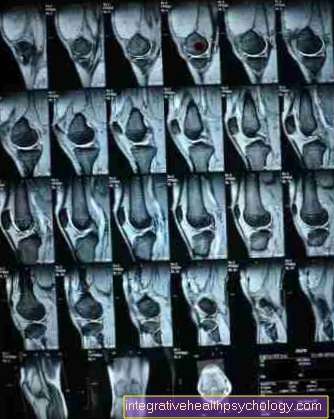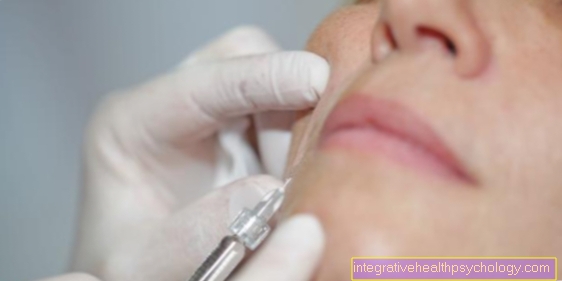Lupus erythematosus
definition
(lupus = wolf, blush; erythematosus = blushing)
Lupus erythematosus is an autoimmune disease belonging to the group of collagenoses. The clinical picture of lupus erythematosus is a systemic disease of the skin, but also of the vascular connective tissue of many organs. In addition, there are so-called vasculitides, i.e. inflammation
- the vessels (vasa = vessel, -itis = inflammation),
- of the small arteries or
- Arterioles (very small arteries).

Occurrence / frequency
Approximately 50 out of 100,000 residents have lupus for the first time.
The incidence rate is between 5 and 10 people per 100,000 inhabitants annually. Women are about ten times more likely to be affected than men. In addition, women in particular childbearing age get sick. Also a so-called "late onset"(" Late start ") is possible. In these cases, the patients only become ill from the age of 55. Again, women are affected more often, but only twice as often.
More details on lupus erythematosus
Both Collagenoses it is a group of diseases that mainly occur in the connective tissue play - in the entire body.
Lupus is one of the Autoimmune diseases. An autoimmune disease is characterized by the fact that the body turns against itself and fights itself. The hereditary Predisposition seems to play a role in these diseases, but the exact cause is unexplained.
In principle, the entire body is affected in lupus erythematosus.
Furthermore, the lupus is one of the Systemic diseases. Such a disease is understood that affects an entire system of the organism, for example the blood-forming system leukemia. So in the case of lupus this will be Vascular system and its connective tissue infested.
It also counts to the disease of lupus that itself Immune complexes deposit which from
- DNA (our heritage),
- complement (a Defense system of the body) and
- fibrin (used for coagulation) exist.
Immune complexes are assemblies of different components. Cells that play a role in the body's own defenses network with the cells that they want to fight and thus form the immune complexes. These are distributed throughout the body by the blood vessel system. The immune complexes can be deposited in almost all organs of the body and cause inflammation. Another conceivable consequence would be the functional impairment of the respective organs.
Cause of lupus erythematosus
The exact cause of the lupus has not yet been clarified.
As a hypothesis (assumption) the following is in the room: DNA (the basic substance of our genetic make-up) is released by a virus infection - which virus is also still unknown. Since there is not enough enzyme available to break down the DNA and thus remove it, there is an immune reaction against the DNA. The immune complexes are now deposited in the vessels and generate the inflammation.
Symptoms of lupus erythematosus
With lupus there are general symptoms like
- Fever,
- Weakness and
- Weight loss before.
It can too
- Weight loss,
- Harness failure and
- swollen lymph nodes come up.
However, these symptoms are very unspecific and say little about the underlying disease. Therefore, further clarification is necessary.
In almost 80% of patients, the joints are also involved, in the sense of joint inflammation in several joints. Most patients with lupus therefore see their doctor for the first time.
The joints
- pain,
- swell and
- patients feel stiff, especially in the morning.
The pain can come from the tendons or the muscles that surround the joint. Inflammation of the muscle tissue occurs in about 40% of patients.
The joints that are most commonly affected are the
- Finger-,
- Hand and
- Knee joints.
Well over half of the patients complain of skin involvement:
- The so-called butterfly erythema is characteristic. This refers to reddening of the skin (erythema) in the form of a butterfly that spreads over the cheeks and the bridge of the nose.
- In addition, red papules with scales form on the skin.
- The skin is sensitive to light.
- Secondary Raynaud's syndrome is rare.
- Ulcer-like changes and tongue stinging also occur on the oral mucosa.
In addition to the skin, the organs can also be affected.However, it is also possible for our largest organ, the skin, to participate alone. In this case one speaks of a cutaneous (cutis = skin) lupus erythematosus.
In the context of organ involvement, changes in the lungs and heart occur in around 60% of cases. Above all, there are pleural and pericardial effusions. This is where fluid collects around the heart or lungs, which limits the size of the organ in question. The heart can no longer pump because the fluid in the pericardium prevents it from expanding. The compression reduces the area for gas exchange in the lungs.
Kidney involvement plays the most important role among the organ manifestations in lupus erythematosus. In most cases, it is the most important component in mortality and morbidity. So it has a major impact on the death rate and the disease rate. If lupus erythematosus is fatal, it is due to kidney failure. Special attention must be paid to these organs during therapy so that they can function without restriction for as long as possible. If the kidneys fail, our blood will no longer be detoxified and our body's cells will fail.
Neurological changes also occur in slightly more than half of the cases. These changes show up in the central nervous system, which includes the brain and spinal cord. These changes can manifest themselves in a wide variety of ways:
- From depression to
- up to epileptic seizures
- Strokes are all conceivable.
There are also characteristic changes in the blood count. On the one hand, there is an increase in the general inflammatory parameters
- CRP value = C-reactive protein,
- ESR = sedimentation rate,
on the other hand, disease-specific findings are groundbreaking. However, CRP and ESR only indicate some kind of inflammation. The information about which inflammation is exactly cannot be obtained from these values. However, it is possible to assess how severe an inflammation is, whether it is progressing or even getting better. The more specific findings include, for example, a wide variety of antibodies (ANA, APA), which are usually directed against the body's own DNA and therefore give us an indication. It should be noted that they can also be increased in other inflammatory autoimmune diseases (e.g. autoimmune hepatitis).
Often there are also fewer blood cells. This can affect both the platelets (Thrombocytopenia), as well as the white blood cells (Leukopenia) affect.
Symptoms of lupus erythematosus

Come with lupus General complaints such as fever, weakness and weight loss. Weight loss, hair loss, and swollen lymph nodes can also occur. However, these symptoms are very unspecific and say little about the underlying disease. Therefore, further clarification is necessary.
In almost 80% of the patients there is also an involvement of the joints, in the sense of joint inflammation of several joints (polyarthritis). Most patients with lupus therefore see their doctor for the first time. The joints hurt, ring and appear stiff to patients, especially in the morning. The pain can come from the tendons or the muscles that surround the joint. The Inflammation of muscle tissue occurs in about 40% of patients. The joints that are most commonly affected are the finger, wrist, and knee joints.
Well over half of the patients complain of involvement of the skin:
-
The so-called butterfly erythema is characteristic. This refers to reddening of the skin (erythema) in the form of a butterfly that spreads over the cheeks and the bridge of the nose.
-
In addition, red papules with scales form on the skin.
-
The skin is sensitive to light.
-
Secondary Raynaud's syndrome is rare.
More on this topic can be found at: Raynaud's Syndrome. -
Ulcer-like changes also occur on the oral mucosa.
In addition to the skin, the organs can also be affected. However, it is also possible for our largest organ, the skin, to participate alone. In this case one speaks of a cutaneous (cutis = skin) lupus erythematosus.
As part of the Organ involvement there are changes in about 60% of the cases lung and des Heart. Above all, there are pleural and pericardial effusions. This is where fluid collects around the heart or lungs, which limits the size of the organ in question. The heart can no longer pump because the fluid in the pericardium prevents it from expanding. The compression reduces the area for gas exchange in the lungs.
The Kidney involvement plays the most important role among the organ manifestations in lupus erythematosus. In most cases it is the most important component of mortality (disease) and mortality (mortality). So it has a major impact on the death rate and the disease rate.
If lupus erythematosus is fatal, it is due to kidney failure. Special attention must be paid to these organs during therapy so that they can function without restriction for as long as possible. If the kidneys fail, our blood will no longer be detoxified and our body's cells will fail.
In a little more than half of the cases it also occurs neurological changes. These changes show up in the central nervous system, which includes the brain and spinal cord. These changes can manifest themselves in a wide variety of ways: From depression to epileptic seizures to stroke, anything is conceivable.
There are also characteristic changes in the blood count. On the one hand, there is an increase in general inflammation parameters (CRP = C-reactive protein, ESR = sedimentation rate), on the other hand, disease-specific findings are groundbreaking. However, CRP and ESR only indicate some kind of inflammation. The information about which inflammation is exactly cannot be obtained from these values. However, it is possible to assess how severe an inflammation is, whether it is progressing or even getting better. The more specific findings include, for example, a wide variety of antibodies (ANA, APA), which are usually directed against the body's own DNA and therefore give us an indication. It should be noted that they can also be increased in other inflammatory autoimmune diseases (e.g. autoimmune hepatitis).
Often there are also fewer blood cells. This can affect both the blood platelets (thrombocytopenia) and the white blood cells (leukopenia).
diagnosis
Certain criteria that must be met are used to make a diagnosis:
- Butterfly erythema
- Photosensitivity
- Arthritis of at least two joints
- Kidney involvement
- Central nervous system involvement
- ANAs (specific antibodies) in the blood
- Fluid in the pericardium or around the lungs (in the pleural space)
At least four of these symptoms must be fulfilled for a diagnosis of lupus erythematosus to be made. Not all relevant symptoms have been listed at this point - it is only an extract.
The diagnosis of lupus erythematosus usually takes place in several steps. In particular, the presence of typical symptoms that occurred during a doctor-patient conversation (anamnese) and an extensive physical examination is an important step in the diagnosis of lupus erythematosus. In addition, the affected organs are specifically examined. Both the production of X-rays of the joints and the implementation of an ultrasound examination are particularly suitable methods in the diagnosis of lupus erythematosus.
Another important step in the diagnosis of lupus erythematosus is the performance of various laboratory tests. In order to be able to collect special laboratory values that are typical for the presence of lupus erythematosus, blood must be drawn from the patient. Typically, people who suffer from lupus erythematosus have antibodies that are directed against the body's own structures. These specific antibodies can be detected in the blood of those affected. For this reason, the detection of autoantibodies is an important part of the diagnosis of lupus erythematosus. In addition, other abnormalities in the laboratory parameters can be observed in most of the affected patients. People with lupus erythematosus usually have increased blood sedimentation and decreased white blood cell counts (Leukocytes) and platelets (Platelets). While the so-called C-reactive protein (CRP) behaves perfectly normally in most cases, many people with lupus erythematosus suffer from severe anemia (anemia). In the course of the diagnosis of lupus erythematosus, the number of complement factors C3 and C4 is also examined. In affected patients, this number is usually significantly reduced. The number of these factors can also be used to monitor the activity of the inflammation in systemic lupus erythematosus.
In addition, tissue examinations can be useful. For this purpose, the attending physician takes small tissue samples from the skin (see: Skin biopsy) and the kidneys and sends them to a special laboratory. Tissue samples in which a so-called lupus band can be detected significantly advance the diagnosis. This lupus band is caused by deposits of immune complexes, especially in the area of sun-exposed skin.
In addition, the kidney tissue sample is an important method in lupus erythematosus diagnostics. In the course of the disease, what is known as "lupus nephritis", an inflammation of the kidneys, often occurs. In the blood, red blood cells arranged in cylinders (Red cell casts) prove. In addition, in the course of the inflammatory reaction, protein is released in the urine and blood pressure rises. Acute impairment of kidney function can also lead to the accumulation of fluid in the tissue (Edema) to be watched. The presence of lupus nephritis has a decisive influence on the most suitable therapy and the course of the disease. In order to ultimately be able to diagnose lupus erythematosus, at least four of eleven possible criteria must be met by definition. In diagnostics, one speaks of so-called ACR criteria.
The following article may also be of interest to you. It includes the description of various autoantibodies and the clinical pictures they cause. Read more about this under: Autoantibodies
blood values
A very important diagnostic tool is blood tests on those affected. Various abnormalities and changes in the blood can be indicators of lupus erythematosus.
A decrease in blood platelets (thrombocytopenia), white blood cells (leukocytopenia) and especially lymphocytes (lymphocytopenia) can be seen in the blood count. Furthermore, changes can be found in the blood test that suggest what is known as hemolytic anemia. Hemolytic anemia is characterized by the breakdown of red blood cells.
It is also characterized by an increased LDH value, an increased indirect bilirubin, an increased reticulocyte value and possibly an increased free hemoglobin. In the case of lupus erythematosus, the so-called Coombs test is carried out to detect the antibodies that are responsible for the disintegration of the erythrocytes. This test is positive for lupus erythematosus. Furthermore, general inflammation values in the blood are examined. This often results in an increase in the so-called sedimentation rate (ESR) with a normal CRP value at the same time, which is used as an indicator of inflammation in the body. Furthermore, the complement factors C3 and C4 may be lowered. These form important components of the immune system.
When diagnosing lupus erythematosus, in addition to these general blood tests, special rheumatological antibody diagnostics are carried out. With the help of specific laboratory procedures (e.g. immunofluorescence test), antibodies are determined which are very important for diagnostics.
A very important value is the so-called ANA value. ANA stands for Antinuclear Antibodies and describes a value that is positive in approx. 95% of patients with lupus erythematosus. Repeated negative ANA values are therefore more likely to speak against lupus. Antibodies against double-stranded DNA, so-called anti-dsDNA antibodies, are also determined. This very specific value is positive in around 70% of those affected. A positive test result in this test speaks very strongly for lupus. The stronger the disease activity and the symptoms, the higher this value is usually. Furthermore, it is often associated with kidney damage in the context of lupus erythematosus (lupus nephritis).
There are other antibodies that are examined in rheumatological antibody diagnostics. These include anti-C1q antibodies and anti-SM antibodies. These values are not often positive, but when they are, it is a very strong indicator of lupus. The so-called SS-A antibodies are also only positive in around 60% of patients. Positive SS-A antibodies are also associated with Sjogren's syndrome, another autoimmune disease. Ultimately, in some cases, antibodies can be found against important components of the blood's coagulation system. Antibodies against blood platelets (thrombocytes) are symptomatically associated with pin-shaped bleeding of the skin and mucous membranes (petechiae).
Another important component of the coagulation system is factor 8, against which antibodies can also be detected. This is often symptomatic of extensive bleeding or joint swelling.
Read more about the topic here: Coomb's test.
Classification of lupus erythematosus

Unfortunately, lupus does not always express itself in the same way and must therefore be diagnosed in a differentiated manner. Classifications can be made.
The disease of lupus erythematosus can be divided into three forms:
- Cutaneous (skin affecting) lupus erythematosus
This form usually only affects the skin and has a good prognosis. The disease either occurs only on isolated areas of the skin (mostly on the head) or affects the entire body (trunk, upper arms). The skin symptoms have a reddish, inflammatory rim (thickened rim) and are indented in the middle due to tissue shrinkage.
- Subcutaneous (under the skin) LE
This form manifests itself through a general feeling of illness, joint and muscle pain, and skin changes. The kidneys are rarely affected here.
- Systemic (affecting an entire system) lupus erythematosus
This lupus is characterized by certain symptoms and appearances that are used for diagnosis (see below). The organs are always affected here - especially the kidneys, which also determine the extent of the disease. If the kidneys are severely affected, the SLE has a poor prognosis - if the kidneys are only slightly affected, the prognosis is better.
Other forms of lupus erythematosus
Other forms of lupus erythematosus:
- Lupus erythematosus tumidus
- Lupus erythematosus dissminatus
- Lupus erythematosus diskoides
- Lupus erythematosus visveralis
Lupus erythematosus tumidus
Lupus erythematodes tumidus is a special form of cutaneous lupus erythematosus and is often referred to as intermittent cutaneous lupus. Cutaneous lupus primarily affects the skin.
Lupus tumidus is primarily characterized by skin changes on the face, neck, décolleté and on the arms and shoulders.
The reddish skin changes, about 0.5-5 cm in size, known as plaques or papules, occur primarily after contact with sunlight. The skin of those affected is very sensitive to light.
In contrast to other cutaneous forms of lupus, flaking of the skin is rather untypical. The skin changes heal without scars. Incidentally, the term "tumidus" means "bloated" and is derived from the appearance of the skin changes.
Lupus erythematosus disseminatus
The term lupus disseminatus is often used as a synonym for systemic lupus erythematosus.
The Lupus miliaris disseminatus faciei has to be distinguished from this. This chronic inflammatory skin disease should not be confused with lupus erythematosus, but is an independent disease.
It is characterized by skin involvement that is mainly associated with red-brown changes in the skin of the eyelids, forehead and cheeks and the cause of which is unclear.
Lupus erythematosus diskoides
Lupus diskoides, or chronic discoid lupus erythematosus (CDLE), is characterized by almost exclusively affecting the skin. The skin changes are usually provoked by sunlight and have a disc-shaped appearance. This is why this form of lupus is also referred to as "discoid".
The disc-shaped skin changes are sharply defined, slightly raised and have a scaly surface. There is often a lightening in the middle. The changes are usually only found in one part of the body and rarely in several body regions at the same time. They heal scarred and lead to hair loss on the hairy scalp (scarred alopecia).
Lupus erythematosus visceralis
Systemic lupus erythematosus was also previously known as visceral lupus, but this term is out of date. In contrast to cutaneous lupus, which only affects the skin, it is a form that in principle can affect any organ. Therefore one speaks of a systemic lupus. What is feared above all is damage to the kidneys or other serious organ damage that can lead to multiple organ failure. However, because systemic lupus is treated with medication, complications can often be prevented.
Lupus and Pregnancy
Pregnancy is not recommended for patients with known active systemic lupus erythematosus SLE. At most in the disease-free periods, if the disease does not occur even without immunosuppression, a pregnancy can be considered after about a symptom-free six months. However, patients with known systemic lupus erythematosus are always at risk of pregnancy!
The desire to become pregnant should be discussed with the treating internists and gynecologists.
Treatment of lupus erythematosus

There is no cure for patients suffering from lupus erythematosus. For this reason, the treatment of this disease focuses on alleviating the typical symptoms. The most suitable therapy for lupus erythematosus depends on which organ systems are impaired and to what extent the disease is manifesting itself. Accordingly, there is no fixed therapeutic scheme for lupus erythematosus. Rather, the type and intensity of treatment must be determined specifically for the patient. Since the presence of lupus erythematosus leads to a pronounced malfunction of the body's own defense (formation of autoantibodies), it is extremely important to suppress the defense reaction of the organism (Immunosuppression).
For this reason, the most important drugs in the therapy of lupus erythematosus include all substances from the active substance group of glucocorticoids. A classic example of such a substance is cortisone. However, these drugs must be administered in a particularly high dose and used over a long period of time. However, due to the high number of possible side effects, many of those affected fear long-term use.
The antimalarial agent is now in effect "Hydroxychloroquine" as an alternative in the therapy of lupus erythematosus. This medicine is said to be particularly suitable when the skin and joints are impaired. Stronger active ingredients such as cyclophosphamide or azathioprine are usually only used in severe forms of lupus erythematosus. They are mainly used in patients who have significant involvement of the kidneys (lupus nephritis), the central nervous system or the heart (heart valve inflammation).
In addition, completely new types of medication are now available for the treatment of lupus erythematosus. Man-made antibodies (Belimumab) are able to inhibit part of the immune cells in lupus erythematosus patients and in this way alleviate the symptoms. The active ingredient mycophenolate mofetil is used in cases in which the administration of classic drugs does not achieve any significant improvement. As a so-called reserve agent, this active ingredient has not yet been officially approved for the treatment of lupus erythematosus. In professional circles one speaks of a so-called "Off-label-use". In addition, the therapy can be carried out by performing a blood wash (Plasmapheresis) in some cases help remove autoantibodies from the circulation.
Patients suffering from lupus erythematosus can also have a positive influence on the course of the disease by taking other drugs. In particular, drugs to lower blood pressure and cholesterol-lowering drugs that minimize the cardiovascular risk should be taken regularly in the treatment of lupus erythematosus. Various pain relievers can be used to relieve pain. In addition, affected patients should refrain from consuming nicotine and place particular emphasis on a diet rich in calcium. The intake of vitamin D3 is also recommended to prevent accompanying osteoporosis.
As tissue damage can occur in patients with lupus erythematosus due to the deposition of immune complexes in sunlit skin areas, those affected should consistently protect themselves from sunlight and other UV radiation. Visiting sunbeds should generally be avoided. In addition, the use of sun protection creams with a particularly high sun protection factor is recommended.
The therapy depends on the type of illness. For example, if the lupus is medication-induced, those medications will be stopped if possible.
The focus is on cortisone and immunosuppressants. Cortisone is primarily intended to inhibit inflammation in the affected organs, while immunosuppressants are intended to suppress the body's own defense system. The latter can be explained by the fact that our immune system in lupus is directed against the body's own cells. The aim is to dampen this undesirable effect.
In the case of cutaneous lupus (i.e. a lupus that is limited to the skin):
- Retinoids (vitamin A derivatives),
- Creams with a high sun protection factor and
- Cortisone ointments
If lupus is one of the most severe types, i.e. systemic lupus erythematosus, the therapy is as follows:
In any case, it is very important to have a good blood pressure control in order to keep the function of the kidneys, which are already endangered by the disease. In cases that are less pronounced and in which no organs are affected, pain relievers such as ASA or Ibuprofen® plus hydrochloroquine are given to treat joint pain. Cortisone is only given in flare-ups.
If there is a severe case with the impairment of (vital) organs, the therapy is different. Here, high doses of cortisone are given and the body's own defense system is suppressed by immunosuppressants.
Cortisone and immunosuppressants suppress the body's defense system. This ensures that the immune complexes that want to fight the deposited DNA do not even form. The body's defenses are so bad that the cause of the disease cannot be combated at all.
With a strong suppression (suppression) of the immune system one has to be careful, however, as there is a high risk of infection for the patient. Even the slightest cold can be dangerous for these patients. The now suppressed and non-working immune system can no longer fight viruses, bacteria and other pathogens.
Read more on the topic: Lupus erythematosus therapy
prophylaxis
Since systemic lupus erythematosus (SLE) is an autoimmune disease, there are no preventive measures. If a person is affected by lupus, regular check-ups by a doctor are recommended. Particular attention is paid to the best individual therapy and attempts are made to keep the side effects as low as possible.
To avoid relapses, however, a few small rules can be observed:
- Patients suffering from Raynaud's syndrome (Raynaud's disease) should avoid the cold and always wear gloves when the temperature is cold or take other precautions against the cold.
Further information is also available under our topic: Raynaud's disease - All patients should avoid the sun or other types of UV light.
- Since lupus can also be triggered by drinking alcohol, it should be avoided.
forecast
Lupus erythematosus is one to this day incurable disease. However, the options for treatment continue to advance. The sooner you start the treatment, the better the course should be.
The SLE has a pretty good prognosis. Compared to previous years, the forecast has improved significantly. The 10-year survival rate is now 90%. The leading cause of death is the Heart attack or the Blood poisoning.
The diagnosis of lupus does not yet constitute a reason to start a drug therapy. It must be decided on a case-by-case basis.
Summary
Of the Lupus erythematosus is a disease of the connective tissue of the vessels and skin. It affects the whole body because they all Organ systems can attack. The cause has not yet been clarified. Women of childbearing age are most commonly affected.
There are different forms of lupus that need to be treated differently. For example, there is a form in which only the skin is affected, but other organs are completely healthy. In order to recognize lupus, one can orientate oneself on certain complaints or abnormalities. A so called Butterfly erythema on the face is very typical and noticeable. Blood values are also included in the diagnosis.
Further topics from this area

Therapy of lupus erythematosus
Lupus erythematosus is an autoimmune disease that is associated with a variety of complaints. There are several drugs that can be used to treat lupus. Here you get to the topic: Lupus erythematosus

rheumatism
Rheumatism is an umbrella term for a variety of diseases of the musculoskeletal system. Almost all diseases have in common, joint pain and swelling of the joints.
Here you get to the topic: Rheumatism





























